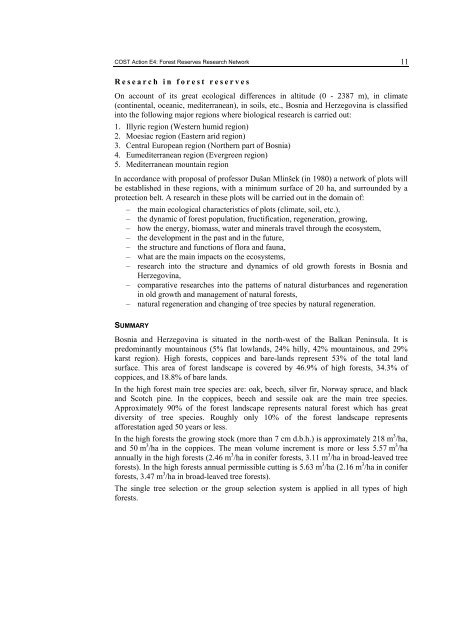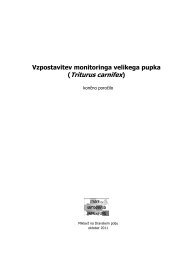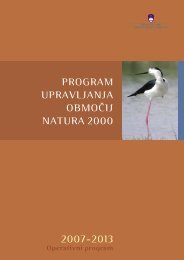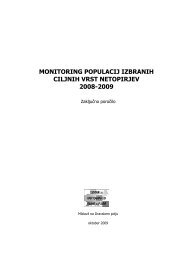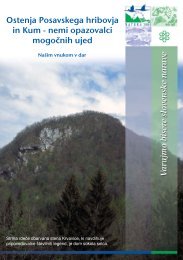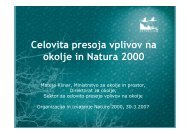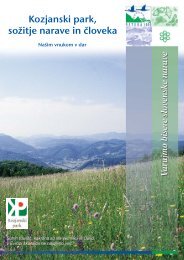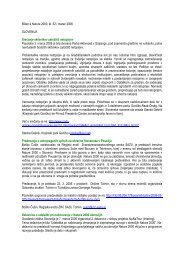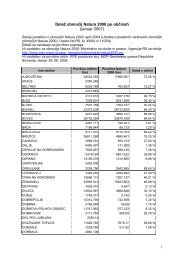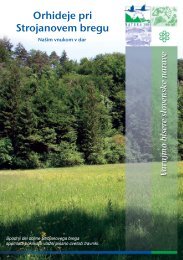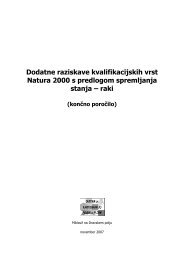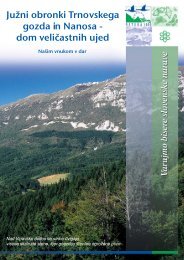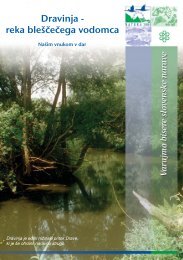VIRGIN FORESTS AND FOREST RESERVES IN ... - Natura 2000
VIRGIN FORESTS AND FOREST RESERVES IN ... - Natura 2000
VIRGIN FORESTS AND FOREST RESERVES IN ... - Natura 2000
Create successful ePaper yourself
Turn your PDF publications into a flip-book with our unique Google optimized e-Paper software.
COST Action E4: Forest Reserves Research Network 11<br />
Research in forest reserves<br />
On account of its great ecological differences in altitude (0 - 2387 m), in climate<br />
(continental, oceanic, mediterranean), in soils, etc., Bosnia and Herzegovina is classified<br />
into the following major regions where biological research is carried out:<br />
1. Illyric region (Western humid region)<br />
2. Moesiac region (Eastern arid region)<br />
3. Central European region (Northern part of Bosnia)<br />
4. Eumediterranean region (Evergreen region)<br />
5. Mediterranean mountain region<br />
In accordance with proposal of professor Dušan Mlinšek (in 1980) a network of plots will<br />
be established in these regions, with a minimum surface of 20 ha, and surrounded by a<br />
protection belt. A research in these plots will be carried out in the domain of:<br />
– the main ecological characteristics of plots (climate, soil, etc.),<br />
– the dynamic of forest population, fructification, regeneration, growing,<br />
– how the energy, biomass, water and minerals travel through the ecosystem,<br />
– the development in the past and in the future,<br />
– the structure and functions of flora and fauna,<br />
– what are the main impacts on the ecosystems,<br />
– research into the structure and dynamics of old growth forests in Bosnia and<br />
Herzegovina,<br />
– comparative researches into the patterns of natural disturbances and regeneration<br />
in old growth and management of natural forests,<br />
– natural regeneration and changing of tree species by natural regeneration.<br />
SUMMARY<br />
Bosnia and Herzegovina is situated in the north-west of the Balkan Peninsula. It is<br />
predominantly mountainous (5% flat lowlands, 24% hilly, 42% mountainous, and 29%<br />
karst region). High forests, coppices and bare-lands represent 53% of the total land<br />
surface. This area of forest landscape is covered by 46.9% of high forests, 34.3% of<br />
coppices, and 18.8% of bare lands.<br />
In the high forest main tree species are: oak, beech, silver fir, Norway spruce, and black<br />
and Scotch pine. In the coppices, beech and sessile oak are the main tree species.<br />
Approximately 90% of the forest landscape represents natural forest which has great<br />
diversity of tree species. Roughly only 10% of the forest landscape represents<br />
afforestation aged 50 years or less.<br />
In the high forests the growing stock (more than 7 cm d.b.h.) is approximately 218 m 3 /ha,<br />
and 50 m 3 /ha in the coppices. The mean volume increment is more or less 5.57 m 3 /ha<br />
annually in the high forests (2.46 m 3 /ha in conifer forests, 3.11 m 3 /ha in broad-leaved tree<br />
forests). In the high forests annual permissible cutting is 5.63 m 3 /ha (2.16 m 3 /ha in conifer<br />
forests, 3.47 m 3 /ha in broad-leaved tree forests).<br />
The single tree selection or the group selection system is applied in all types of high<br />
forests.


